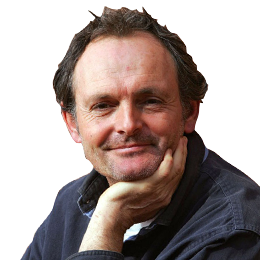HEADING FOR THE HILLS
The art of friendship
What can we do for Pere? Touching elbows just doesn’t cut it.
The 80-year-old blacksmith, mop of grey curly hair, flat lip from pipe-smoking, easy smile and gentle nature, has gifted us more of his metal art. And that is not all we have received from him.
He is in many ways the face of our community – patient, giving, rooted and accepting. He has taken us back in time.
The village nestles against a great cone of rock, the tree-coated limestone and red sandstone dominating the horizon to the west of our house, hence beautifully silhouetted at sunset. And it is at the heart of this tale, a union of art and history.
For millennia La Miloquera mountain, named after an owl, has been a home, a refuge – from prehistory to now. It has been a perfect place; safe, close to water and overlooking fertile, workable lands. The community no longer perches on the high ground, but the marks remain and the echoes abound. Until his death in 2006, the house that still sits just below the summit was the last home and workshop of the sculptor Marçà-Giné. Pere helps to keep all of these threads alive.
I needed to see him.
I made my way on foot down past La Miloquera towards the gorge that separates it from the imposing ridge rising to greet the Serra de Llaberia. A golden oriole was singing in the trees, a warbler in the reeds. We as a family call it The Shire, as in Hobbit land. Pere is neither diminutive nor has pointed ears, but that quiet space by the river is verdant and decorated with vegetable gardens and tiny, attractive stone casetas with something of the pastoral Shire about it all, as conjured by Tolkien in Lord of The Rings. Pere’s terrain is much the same as the others, except for the metalwork sculpture of Don Quixot beside the tomato plants.
In retirement he keeps patiently working the hammer and the anvil. Now we have a gift of friendship to fit the times – two figures touching elbows, wearing facemasks. Once, when we somehow lost one of the two vast keys to our ancient farmhouse door he gifted us a replacement. I have two other pieces of his iron art. And then there are the two wondrous stones he wanted us to have, to hold, to appreciate. We do.
When he was a boy Pere would visit Marçà-Giné, the start of a life-long friendship. There in a wooden box the boy saw a collection of stone hand tools, the craft of valley dwellers from thousands of years ago. Marçà-Giné’s box was the beginning of a never-ending, patient search for more, one that has taken Pere back and forth across La Miloquera and up the river valley, to caverns and cliff edges. He has, over the years, found enough history to fill a house. His dedication tells a story, one that now has made its way into museums in Reus.
And Pere knows access matters. When not down in The Shire or in his forge he might be found on the weekend on a bench enjoying a pipe, waiting outside the village museum to welcome anyone who might be interested.
Museum is, for me, a misnomer. Set in Marçà-Giné’s earlier village home it is more an art experience, a gallery, an exhibition, a rare and vital collection not only of Marçà-Giné’s creations and the art of his wife Lula Pérez but of other work and the lives within a valley and upon a little mountain.
How can I possibly thank Pere? I can write about him.


